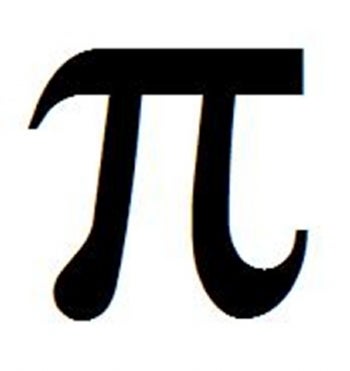Discovering Pi (3-16 thru 3-22)
In observance of Pi week (Pi day is March 14 -- 3.14), we had the children discover Pi as the ancient Chinese (3), Babylonians (25/8), Egyptians (256/81), and the Greeks (3.1485) did.
After paraphrasing the book Sir Cumference and the Dragon of Pi, we had them measure diameters of circles and spheres (more challenging) and then took string the distance of the diameter and measured the number of times that diameter could fit on the circumference. The children were most focused on the remaining fraction after 3 diameters. In order to estimate 1/7, they took the diameter string and folded in half, half, and half again to confirm that 1/8 was too small and 1/4 was too big. They were fascinated by the pie dish that my Mathletes bought me a few years back which has the letter pi in the middle and a hundred digits of pi around the edge.
The week's is for them to find any circle or sphere in their house and measure the diameter and test the 3 and 1/7 theory.
I found this article on PC World that you may find interesting:
A Brief History of Pi
In honor of Pi Day (March 14), we bring you a brief history of everyone's favorite irrational constant.
Sarah Jacobsson, PCWorld

Everybody knows that the value of pi is 3.14…er, something, but how many people know where the ratio came from? Actually, the ratio came from nature--it's the ratio between the circumference of a circle and its diameter, and it was always there, just waiting to be discovered. But who discovered it? In honor of pi day, here's a brief (sort of) history of how pi came to be known as 3.14(1592653589793238462643383279502884197169…etc).
It's hard to pinpoint who, exactly, first became conscious of the constant ratio between the circumference of a circle and its diameter, as human civilizations seem to have been aware of it as early as 2550 BC. The Great Pyramid at Giza, which was built between 2550 and 2500 BC, has a perimeter of 1760 cubits (one cubit is about 18 inches, though it was measured by a person's forearm length and thus varied) and a height of 280 cubits, which gives it a ratio of 1760/280 or approximately 2 times pi. Egyptologists believe these proportions were chosen for symbolic reasons, but, of course, we can never be too sure.
The earliest textual evidence of pi dates back to 1900 BC; both the Babylonians and the Egyptians had a rough idea of the value. The Babylonians estimated pi to be about 25/8, while the Egyptians estimated it to be about 256/81.
The Ancient Greek mathematician Archimedes of Syracuse (287-212 BC) is largely considered to be the first to calculate an accurate estimation of the value of pi. He accomplished this by finding the areas of two polygons: the polygon that was inscribed inside the circle, and the polygon in which the circle was circumscribed (see fig. 1). Archimedes didn't calculate the exact value of pi, but rather came up with a very close approximation--he used 96-sided polygons to find an average value of 3.1485.

Chinese mathematician Zhu Chongzhi (AD 429-500) used a similar method to approximate the value of pi, using a 12,288-sided polygon. His best approximation was 355/113.
Pi, or, at least, the approximate ratio, also appears in the Bible:
"And he made a molten sea, ten cubit from the one brim to the other: it was round all about, and his height was five cubits: and a line of thirty cubits did compass it round about." --1 Kings 7:23
(It should be noted that the Biblical ratio for pi could be more accurate than one might think, since cubits changed depending on a person's forearm length. So, assuming the Bible isn't quoting cubits from the same person each time…)
In the 15th century, Indian mathematician Madhavan of Sangamagramam discovered what is now known as the Madhava-Leibniz series (named after German mathematician Gottfried Leibniz, who rediscovered the series in the 17th century), an infinite series that converges to four, and was subsequently able to calculate pi to 11 decimal places.
The Greek letter pi (p) was first used to denote the constant ratio in 1707, by Welsh mathematician William Jones, though the use of the symbol was not popularized until 1737 by Swiss mathematician and physicist, Leonhard Euler. Pi was taken from the Greek word for perimeter.
The most accurate calculation of pi before the advent of the computer was by D. F. Ferguson, who calculated pi to 620 digits in 1945 (previously, William Shanks had calculated pi to 707 digits in 1874, but only 527 of said digits were correct).
Of course, then computers entered the picture and calculating pi knew no bounds--beginning with D. F. Ferguson's calculation of pi to 710 digits in 1947 with a desk calculator to Takahashi Kanada's calculation of pi to 206,158,430,000 digits in 1999 with a Hitachi SR8000. The longest calculation of pi to date was performed in 2002 by a team at the University of Tokyo--1,241,100,000,000 digits, with the help of Hitachi.
So there you have it--Egyptians calculated pi using pyramids (or did they calculate pyramids using pi?), Archimedes busted out the 96-gon, Zhu Chongzhi one-upped him with a 12,288-gon (or is that 12,192-upped him?), Ferguson calculated 620 digits by hand, and the University of Tokyo used a Japanese super-machine to calculate a mere 1,241,100,000,000 digits.
Aren't you glad they did all that work for you, and that all you have to do on pi day is troll geek havens in search of free pie?
